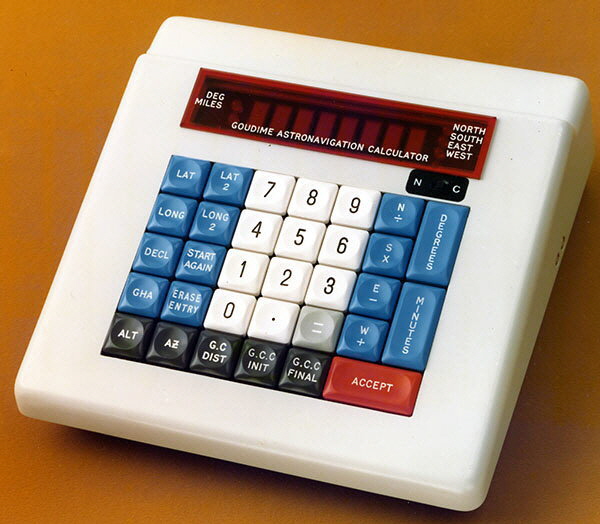


Goudime Astronavigation Calculator
A Prototype Navigation Calculator from 1975 based on the the Intel 8080 Microprocessor
© 2022 & 2024 Barry Eliades, Steve Trigwell & Nigel Tout
This is a new article which was not originally in "The International Calculator Collector".
Goudime Astronavigation Calculator Prototype

Barry Eliades explains: "I designed and built the first dedicated Astronavigation Calculator in 1975. Only two were built as prototypes based on the Intel 8080 microprocessor, one of the first applications of the chip in the UK! When the Department of Trade and Industry (DTI) was approached in 1975 for support in developing the product their response was that microcomputers would never end up in commercial devices! A few months later after displaying the device at the London Boat Show in 1976 [a comparable model] was offered for sale by the Japanese company Tamaya! So much for British Government support for innovation!"
Sadly I don't have any more photos and all the schematics are lost. At the time I was with a small firm called Hyperon Consulting (not Hyperion) and we specialised in leading edge technology. The calculator was developed for a client, Paul Goudime, who had a company making accurate ships' chronometers. He approached us and we produced two prototypes which were handed over to him. After being rejected by the DTI he lost interest in taking it further although I believe Clare Francis [the first woman to captain a successful boat on the Whitbread Around the World yacht race] used one of the prototypes during the Observer Single-handed Transatlantic Race in 1976. I have no idea where the calculators ended up and Paul passed away some time ago.
Development was all very hands on and I was limited on how much memory I could have with the EPROMs [Erasable, Programmable, Read-Only Memories] available at the time. I had to learn about astronavigation and how to use a sextant before going on to develop all the spherical trigonometry calculations in machine code and eventually with an assembler, burning the EPROMS from a punched paper tape. At least you could erase the EPROM under UV light so you could easily correct any errors. The early design was based on the 4004 microprocessor, I then moved to the 4040 and finally the 8080.
When I look back we were at the cutting edge of microprocessor applications with young graduates working in converted garages! Unfortunately those in Government, up to that time, had no interest in, or understanding of, computing and computer technology and allowed the 'crown jewels' developed by UK engineers, mathematicians and scientists to be handed over to U.S. companies."
Grateful thanks to Barry Eliades for providing the photograph and information about this calculator.
Steve Trigwell explains further about the development of this calculator: "In the seventies I started working for Hyperon as an Electronic design engineer. Hyperon was only a small company with about 8 or 9 employees.
The MD was Don Wood, and Barry Eliades was his best friend from school days I believe. They both studied at Sussex University and then Don set up Hyperon, although he had his fingers in many other pies.
I am not sure what Barry's role was then, he was senior to me and may have been project manager. Anyway, I can say that I was totally responsible for the detailed design of the hardware and firmware of the Goudime Astronavigation Calculator. I copied an open source floating point maths routine and studied Astronavigation to enable me to implement the firmware.
The story about the DTI is a little misleading, as the competitor Tamaya was a large Japanese company with access to chip manufacturing facilities to enable them to create much smaller and economically powered devices, the Tamaya NC-2. Although we produced a great computer I don't think it was the right technology."
Grateful thanks to Steve Trigwell for providing this insight into the development of this interesting calculator.
The journal Electronics reported on this navigation calculator[1]:
"Trade winds blow profits for nautical gear
Brisk trade winds are blowing pleasure-boat makers through good years and taking marine-electronics companies with them. That sunny forecast was underlined at this month's International Boat Show in London, where
electronics companies were busy writing up sales of new hardware to intrepid yachtsmen. ...
Intriguing uses of electronics technology also highlight the marketplace. Rigel Instruments Ltd., Petersfield,
Hants., for example, has brought the microprocessor on board for its new $680 Astronavigation calculator, says chairman Paul Goudime. Based on the Intel 8080 chip set, the instrument enables the single-handed navigator to
quickly find his position."
Alas, this navigation calculator never progressed to commercial production.
Several early commercial hand-held navigation calculators can be found on the Featured Hand-held Calculators page.
Reference:
Calculator Articles
Vintage Calculators
Text & photographs copyright, except where stated otherwise, © Nigel Tout 2000-2026.